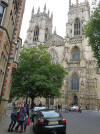
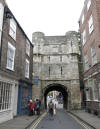








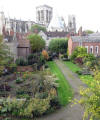



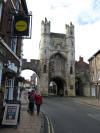
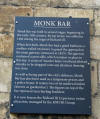

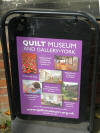
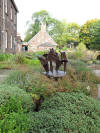


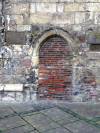
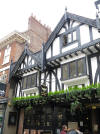




Yorkshire, England 2015 - York
return to Yorkshire trip index
return to mdimage site index
On our second visit to York, on a Saturday, it was uncrowded at first, as we walked the old Medieval wall. At the south end we stopped at the York Quilt Center which had an enjoyable art exhibit, in an attractive 1500's building with an incredible ceiling, but photos were not allowed.
By noon the narrow streets of York were unbelievably crowded. High end clothing and weekend shoppers seems to be the thing here & the stores were packed.
We detoured off the main drag into an old Tudor style Pub for lunch, with a low ceiling & I had to duck.
Then we headed south, away from the crowds, visiting interesting Fairfax House where again photos were not allowed. The tour here is worth taking because the history is so interesting.
note 1 - the Steak and Ale pastry tasted much better than it looks, but the green beans were out of a can, and, the mashed potatoes were heavy. It was only noon so they must have been yesterdays mash.
Fairfax House originally belonged to Charles Fairfax, 9th Viscount of Embley, which was an Irish Peerage. Charles passed away in 1772, leaving the house to his only surviving child, Anne Fairfax, then in her early 20s.
Charles was a City sophisticate, deeply engaged with modernizing York, but his daughter Anne was withdrawn & very religious. After her father died, she walked out of her marriage ceremony, selling the in-town property for a good price, and moving to the family estate at Gilling Castle, next to Ampleforth College, about 6 miles from Kilburn Park.
Anne remained at her country estate, a pious parishioner, for the rest of her life. Her fiscal support helped Ampleforth Abbey to be built.
We drove past the Ampleforth area twice, once after getting lost, driving home from Rievaulx Abbey, and again later (knowingly) on the return drive from Castle Howard. The buildings are in a gorgeous setting, with wooded rolling hills and attractive farm fields all around.
Fairfax House (circa 1762) as it is now, came about through dedicated restoration projects over decades, funded by York philanthropists. It is a great example of Georgian architecture, and contains the "Noel Terry collection" of furniture and clocks.
Noel Terry was born in York in 1889 and lived there until his death in 1979. He assembled what auction house Christies has called "one of the best private collections of late 1600s and early 1700s furniture and clocks in the UK."
The docent said the 13 ancient clocks in the Collection still keep perfect time, none having ever been adjusted, although they are daily wound. It is a mechanical wonder that these 13 clock mechanisms have been accurate for around 250 years.
On the quarter hour, then, tourists at Fairfax House (on three floors) are treated to a lovely chimes concert.
go to next page - Coxwold, Byland Abbey & Helmsley Castle
return to Yorkshire trip index
return to mdimage site index